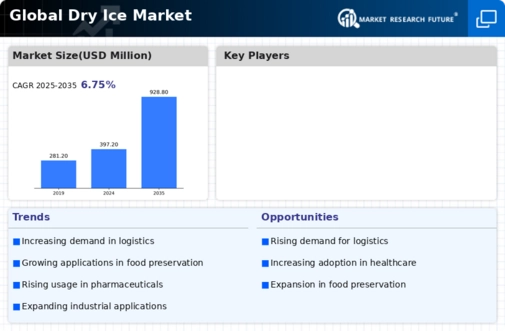Market Trends
Key Emerging Trends in the Dry Ice Market
The need for Dry Ice has seen significant advancements as a result of the convergence of artificial operations, changing consumer behavior, and global events. Increasingly, the dry ice industry is seeing a rise in demand, particularly for the shipping and storage of pharmaceuticals, vaccines, and other temperature-sensitive medical supplies. The trend of rapid distribution of temperature-sensitive items has been highlighted by the COVID-19 pandemic, highlighting the vital role that dry ice plays in preserving their integrity. The need for dry ice in the medical profession is expected to increase as pharmaceutical market grows and new healthcare concerns arise. The growing popularity of e-commerce and the surge in demand for perishable and frozen foods are two more significant factors driving demand trends in the Dry Ice market. Deliveries of frozen items and online grocery shopping have become less common, requiring reliable and efficient cold chain operations. The demand has grown since dry ice is essential for keeping these commodities at the necessary low temperatures while they are being transported and stored. E-commerce's convenience and security have increased demand for creative packaging solutions that preserve product freshness and quality by using dry ice. The market of food and drinks also plays a big role in the trends of Dry Ice markets. The need for dry ice in food donation and medication has increased as customers want for more distinctive and engaging eating experiences. To create dramatic visual effects, like fog or bank, dry ice is employed, which improves the whole eating experience. This trend is especially prevalent in the hospitality industry, as mixologists and cooks use dry ice to give their edibles and culinary creations a little of showmanship. Beyond only being aesthetically pleasing, dry ice is also used in food market to flash freeze and preserve food quality. Since conventional refrigerants have an influence on the environment, environmental sustainability has become a key component of the Dry Ice market. As a solid form of carbon dioxide (CO2), dry ice is thought to be a more environmentally benign choice than traditional refrigerants. This move in the direction of sustainability is consistent with the larger business and social focus on cutting carbon emissions and promoting environmentally friendly behaviors. In response, producers of dry ice market are making investments in ecologically friendly product methods, sustainable sourcing, and novel approaches to reduce environmental effect, all of which help to meet consumer demand for environmental consciousness. Another area influencing the Dry Ice market is aerospace diligence, especially in the areas of satellite launches and space exploration. During the production and testing stages, satellite factors are cooled and exerted using dry ice. The need for dry ice in aerospace operations is expected to increase as space exploration experiments continue to develop. Because of its distinct properties, such as its ability to sublimate at low temperatures, dry ice is a valuable resource in the aerospace industry when it comes to establishing controlled environments for sensitive components and equipment.




Leave a Comment